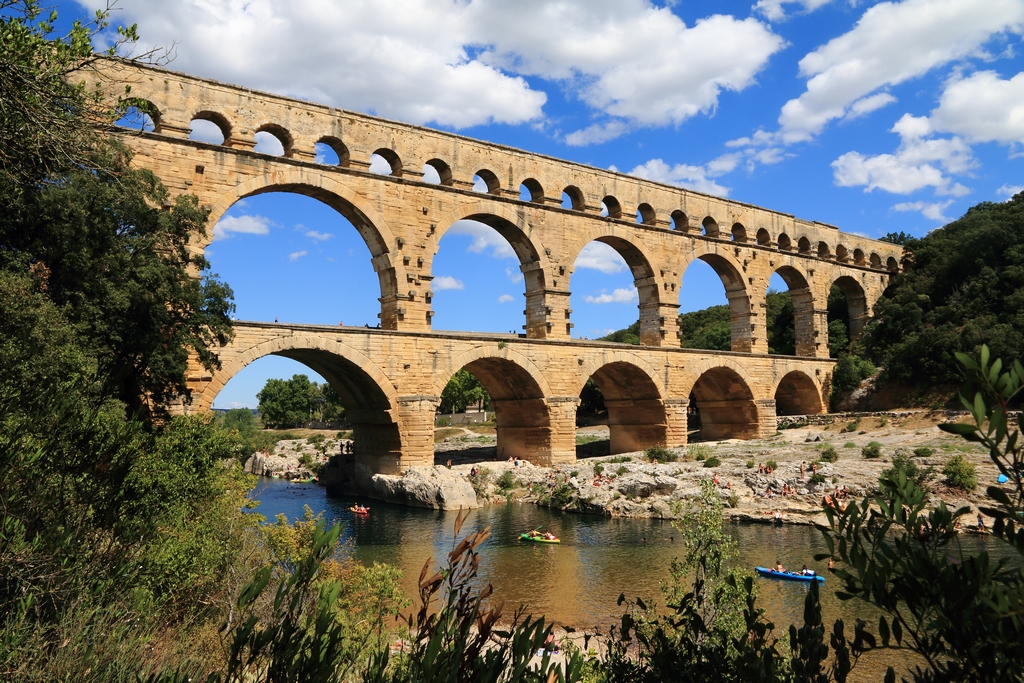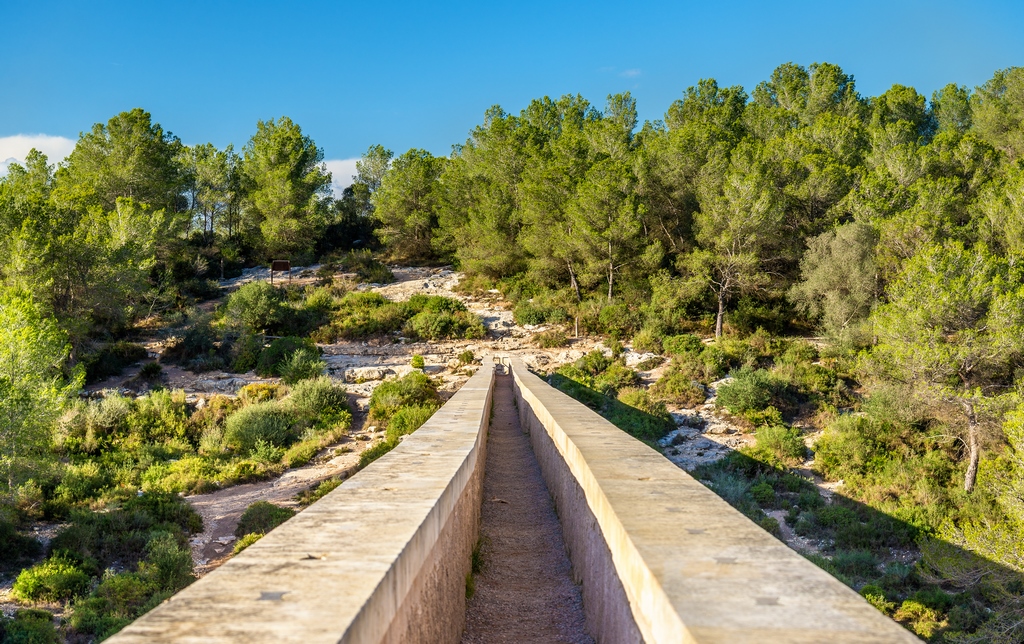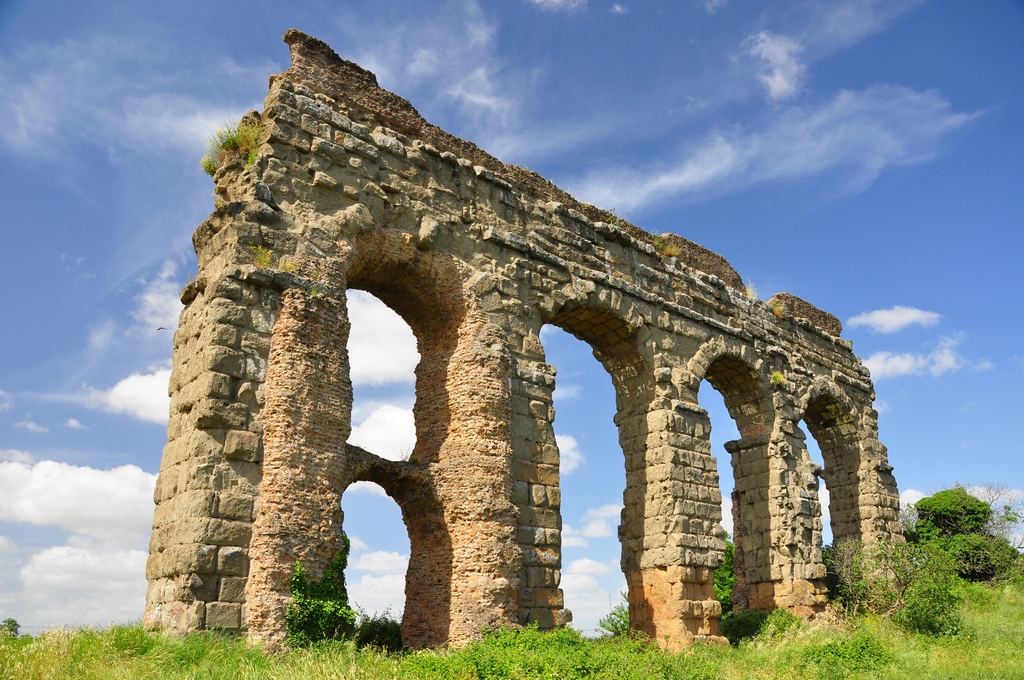Roman Aqueducts: Masterworks of Classic Engineering


The aqueducts it built stand as enduring symbols of the ingenuity and engineering prowess of the Roman Empire. They are among the world’s most historically significant and celebrated man-made hydraulic structures, as they continue to inspire architects and engineers to this day.
By Eric Herman
Built more than 2,000 years ago, large portions still stand, and some even still work. The Roman aqueducts defined modern water distribution systems, and remain enduring testaments to the empire’s remarkable ingenuity.
Ancient prototypes for modern water-distribution systems, the aqueducts enabled the empire to expand and unify its diverse and, in many cases, conquered populations. By developing livable urban environments via the reliable transportation of water over long distances, Rome quelled possible unrest and built many of the world’s greatest cities in the process.
In many ways, the aqueducts stand, literally and figuratively, as the empire’s most influential and enduring innovations. The first aqueduct was the Aqua Appia, erected in 312 BC by the censor Appius Claudius Caecus (c. 340 to 273 BC). During the Republican period, three more aqueducts were built: the Anio Vetus (272 to 269 BC), Aqua Marcia (144 to 140 BC), and Aqua Tepula (126 to 125 BC) (Bruun 2013, 298).
The word, aqueduct, is Latin for “water conduit.” According to author and historian, Elizabeth Diehl: “The concept of an aqueduct was not new to the Romans. Ancient Babylonians, Minoans, Greeks, and Egyptians all used the technology to channel water to their people as well. The earlier people group in the western region of Italy, the Etruscans, also had a system of trenches and were masters at diverting water for their benefit.
But the Romans fine-tuned the technology and delivered fresh water on a much grander scale than previous civilizations, she adds. “Rome is set close to the Tiber River, and the river was a main source of water for the growing population at first. The ancient Romans recognized that the river was polluted from human and animal waste and that they needed to drink fresh water instead of what was in the river. Early Romans also collected rain water in barrels, much like many people do today, but these were dependent on the rainfall, and could be hard to count on.”

DARING DESIGN
Building the aqueducts required the coordination of a cadre of designers and engineers, and a massive, often-enslaved workforce. Although there were many design iterations, they all shared essential common elements:
Aqueducts began at a water source, typically a spring or river. Roman surveyors and hydrologist assayed sites for purity, reliability, location and elevation.
Arguably the greatest achievement of the aqueducts are the networks of conveyances that were planned, designed and built relative to the topography. These massive plumbing systems were made using a spectrum of materials, including concrete (one of Romes greatest innovations) stone, and, in some cases, lead pipes — carrying water over great distances to more locations than had ever been achieved before.
Because aqueducts often crossed valleys, rivers, and uneven terrain using elevated stone and concrete bridges, the aqueducts’ most visible architectural element. Engineering marvels in their own right, the often massive structures made innovative use of arches and masonry techniques. Many still stand among the most photographed ruins in the world.
In what amounts to an early version of mass filtration, aqueducts included settling basins where the water slowed down before reaching the city allowing particulate to fall to the bottom.
Finally, the aqueducts fed networks of pipes within city interiors, distributing fresh water to public baths, fountains, and private homes. This essential modern service was key in affording city dwellers their unprecedented quality of life.
ENGINEERING MARVELS
Several factors contributed to their success, but they are not entirely original. In many ways, the aqueducts were modeled on the Assyrian qanats, hillside tunnels dug to access aquiferous stratum, one of the world’s earliest water “public utility” projects. And they utilized design elements and construction techniques invented by the Greeks, but on a far larger scale.
Roman engineers used precise surveying techniques to ensure that the aqueducts followed a gentle slope, using gravity to create a constant flow of water over long distances. Roman surveyors developed new instruments including the groma and dioptra for accurate measurements.
Aqueduct builders understood materials, including the earliest uses of concrete, known as opus caementicium, a groundbreaking innovation that enabled construction of large, durable arches and conduits.
The Romans also developed a system for maintaining their aqueducts, which were inspected regularly, and repairs were promptly made. Water quality was monitored to ensure its purity.
CONCRETE CONTRIBUTIONS
Aqueduct construction relied largely on its most innovative construction material: pozzolanic concrete, a highly durable concrete that gave Roman structures their incredible strength.
According to an article published in Science Alert in March 2023: The properties of this concrete have generally been attributed to its ingredients: pozzolana, a mix of volcanic ash – named after the Italian city of Pozzuoli, where a significant deposit of it can be found, and lime. When mixed with water, the two materials can react to produce strong concrete.
According to the Science Alert reporting, an international research team carefully studied 2,000-year-old samples of Roman concrete from the archaeological site of Privernum in Italy.
The researchers determined that Romans used quicklime, calcium oxide, mixed with water and pozzolans at high temperatures creating concrete that in effect has “self-healing” qualities.
ENDURING FAME

As mention above, Roman aqueducts continue to inspire historians, architects, engineers, artists, travelers and dreamers from the world over. Some of the most renowned examples include:
Aqua Appia
The first Roman aqueduct, built in 312 BC by Appius Claudius Caecus. It transported water from the Anio River into Rome.
Aqua Marcia
Constructed in 144 BC by Quintus Marcius Rex, this aqueduct supplied fresh water to Rome for centuries.
Aqua Claudia and Anio Novus
Emperor Caligula and later Emperor Nero extended and improved the aqueducts. Aqua Claudia was particularly impressive, featuring massive arches that spanned the Roman Campagna.
Aqua Virgo
Built in 19 BC and one of the remaining functioning aqueducts, Aqua Virgo still supplies water to the Trevi Fountain in Rome today.
Societal Significance
Roman aqueducts had a profound impact on Roman society and the cities they served. Access to a reliable water supply improved public health by enabling sanitation, public baths, and clean drinking water.
The availability of water allowed Roman cities to grow and flourish. Public fountains and baths became important social and cultural centers. The water from aqueducts supported agriculture, enabling the irrigation of crops, and early powered mills and industrial processes, using principles that would be picked up millennia later during the Industrial Revolution.
There was also a political aspect to the aqueducts’ construction. They became a symbol of Roman power and engineering superiority, helping to consolidate Roman control over newly conquered territories.
ENDURING MONUMENTS
Some Roman aqueducts continued to provide water to cities for centuries, and a few still operate today, reflecting the enduring engineering quality of these structures.
Roman aqueducts are monuments to the foresight, engineering genius, and resourcefulness of the empire’s designers and builders. These extraordinary structures not only brought fresh water to their cities but also had a profound impact on public health, urban development, agriculture, and industry.
They remain a testament to the impressive technical legacy of the Roman Empire as serve as an enduring source of inspiration for modern engineers, architects and watershapers.
References
“Water Distribution in Ancient Rome: The Evidence of Frontinus” by Harry B. Evans
“Aqueduct Hunting in the Seventeenth Century: Raffaello Fabretti’s De Aquis et Aquaeductibus Veteris Romae” by Harry B. Evans and Paul Brown
“Roman Aqueducts and Water Supply” by A. Trevor Hodge
“The Aqueducts of Ancient Rome” by Christof Flügel
“The Roman Aqueducts of Caesarea Maritima, Israel” by Jonathan Seligman
Photos by StevenZZ | Shutterstock









